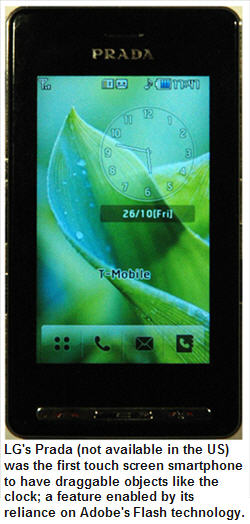Adobe claims Flash's non-PC footprint alone will be 1 billion by 2010

Last week, in the course of asking if Adobe could or should follow in salesforce.com’s platform as a service (PaaS) shoes, I wondered aloud what 300 million devices Adobe CEO Bruce Chizen was referring to when he cited that number as being the current global non-PC footprint of Flash. I couldn't find any references to Flash and a number of that size other than a reference to China Mobile's 300 million subscribers, all of whom are potential targets for Flash Lite given that carrier's plans for Flash.
Adobe's PR department however was on its toes when that story appeared on the Web. That same night I was notified that Adobe does indeed claim that there are indeed 300 million non-PC devices (eg: handsets, phones, etc.) that are enabled with Flash and that Adobe anticipates that number to reach 1 billion by 2010. To back it up, here's the data that an Adobe spokesperson sent to me
- 85% of all handsets that are shipping in Japan and more than 90% of all new DoCoMo handsets are Flash enabled.
- DoCoMo has a total of 52.9M subs, generated 1.8 Billion US$ in revenue for the Flash Lite download service and 600M in incremental, annualized revenue for i-channel – DoCoMo’s Flash Cast service. (as of April ‘07)
- i-channel passed 10M subs in April – less than 18 months after service launch.
- More than 70% of Flash devices are now shipping outside of Japan.
- Verizon is now selling 13 Flash enabled handsets and will launch their Flash Cast service in the U.S. by the end of this year.
- Flash UIs in popular phones include the LG Chocolate, the LG Prada and the Samsung D900, which won best in show at 3GSM ‘07.
- Adobe partners with the top 6 and vast majority of the top 20 OEMs including Nokia, SEMC, Samsung, LG, and Motorola.
- Adobe partners with key operators including Verizon, DoCoMo, China Mobile, Chungwha, and Telenor and has many other trials under way.

Even Java's footprint is going to be one of Silverlight's challenges. With the number of handsets far exceeding the number of PCs and with developers looking to reach the biggest targets of customers, Silverlight will have to go even more cross platform than it already has gone (new territory for Microsoft in the first place). For example, it will have replicate the platform support that both Flash and Java have established for themselves in the mobile space (Windows Mobile, Symbian, Linux, PalmOS as well as whatever proprietary kernels and or OSes are on many of the smaller phone devices).
As an fyi, I've got the LG Prada here (pictured left) even though it's not available in the US. The roughly $750 smartphone has got what appears to be a fully Flash-enabled touchscreen user interface that runs on top of what is very likely a Symbian-based kernel much like the prototype touch screen phone that Synaptics showed me at CES. Both Synaptics and LG have been mum about the underlying kernel in the Prada. But LG's other phones run on Symbian and there's a version of Flash Lite that runs on Symbian. You do the math. The LG Prada was actually the first touch screen phone on the market with iPhone like object dragging capabilities and is a great proof of concept regarding the extent to which Flash can enable animated user interfaces that are only limited in design and function by the phone manufacturers creativity.
The day I'm waiting for is when we can simply skin our phones so that you and I can have the exact same Flash-based phones but with completely different UIs. Given what LG has done with the Prada, it's hard to imagine a world where you couldn't do this.
Anyway, bottom line.... Adobe's Flash is big. So big that it it might not be long before other players start screaming foul (you know, "antitrust foul").